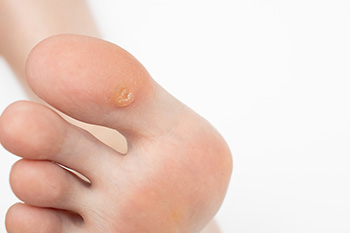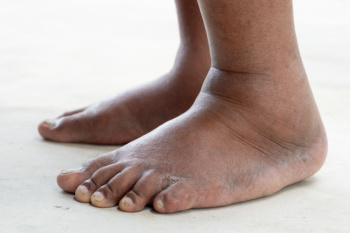Connect With Us
Blog

Plantar warts are small growths that develop on the bottom of the feet, often on the heels or toes, where pressure and friction occur. They are caused by the human papillomavirus, which enters the skin through tiny cuts or breaks. These warts may appear as rough, grainy bumps with black pinpoints and can cause pain or discomfort when walking or standing. Because they can spread or become persistent, professional care is important. A podiatrist can accurately diagnose plantar warts, remove them safely, and provide treatment to prevent recurrence. If you have pain or notice unusual spots on your heels or toes, it is suggested that you consult a podiatrist for an expert evaluation and appropriate treatment solutions.
Plantar warts can be very uncomfortable. If you need your feet checked, contact Darlyne Cange, DPM from Cange Podiatry, DPM, PA. Our doctor will assist you with all of your foot and ankle needs.
About Plantar Warts
Plantar warts are the result of HPV, or human papillomavirus, getting into open wounds on the feet. They are mostly found on the heels or balls of the feet.
While plantar warts are generally harmless, those experiencing excessive pain or those suffering from diabetes or a compromised immune system require immediate medical care. Plantar warts are easily diagnosed, usually through scraping off a bit of rough skin or by getting a biopsy.
Symptoms
- Lesions on the bottom of your feet, usually rough and grainy
- Hard or thick callused spots
- Wart seeds, which are small clotted blood vessels that look like little black spots
- Pain, discomfort, or tenderness of your feet when walking or standing
Treatment
- Freezing
- Electric tool removal
- Laser Treatment
- Topical Creams (prescription only)
- Over-the-counter medications
To help prevent developing plantar warts, avoid walking barefoot over abrasive surfaces that can cause cuts or wounds for HPV to get into. Avoiding direct contact with other warts, as well as not picking or rubbing existing warts, can help prevent the further spread of plantar warts. However, if you think you have developed plantar warts, speak to your podiatrist. He or she can diagnose the warts on your feet and recommend the appropriate treatment options.
If you have any questions, please feel free to contact our offices located in Glen Burnie and Ellicott City, MD . We offer the newest diagnostic and treatment technologies for all your foot care needs.

Swollen feet and ankles occur when excess fluid accumulates in the lower limbs, a condition known as edema. This swelling can cause discomfort, tightness, or a heavy sensation in the legs. Common causes include blood clots, venous insufficiency, varicose veins, and prolonged standing or sitting, all of which can affect circulation and lead to fluid retention or more serious complications if untreated. A podiatrist can determine the underlying cause with a thorough physical examination, imaging studies, and lab testing to check for conditions like kidney, liver, or heart issues that may contribute to swelling. Treatment may include compression therapy, lifestyle modifications, and custom orthotics to improve circulation. If your feet and ankles have become swollen, it is suggested that you consult a podiatrist who can determine the cause is, and offer relief and treatment solutions.
Swollen feet can be a sign of an underlying condition. If you have any concerns, contact Darlyne Cange, DPM of Cange Podiatry, DPM, PA. Our doctor can provide the care you need to keep you pain-free and on your feet.
Swollen feet are a common ailment among pregnant women and people who stand or sit for extended periods. Aging may increase the possibility of swollen feet and patients who are obese often notice when their feet are swelling too. There may be medical reasons why swollen feet occur:
- Phlebitis - A condition that causes the veins to become inflamed and can also cause leg pain.
- Liver disease - This may lead to low blood levels of albumin which is a protein. This can cause fluid in the blood to pass into the tissues and several areas of the body can become swollen.
- Heart failure - When the heart doesn’t pump properly the blood that is normally pumped back to the heart can pool in the veins of the legs causing swollen feet.
- Kidney disease - One of the main functions of the kidneys is releasing excess fluid in the body. This type of condition can make it difficult for the kidneys to function properly, and as a result the feet may become swollen.
- Deep-vein thrombosis (DVT)- This is a serious condition where blood clots form in the veins of the legs. They can block the return of blood from the legs to the heart which may cause the feet to swell. It is important to be treated by a podiatrist if this condition is present.
Swollen feet can also be caused by bone and tendon conditions, including fractures, arthritis, and tendinitis. Additionally, there may be skin and toenail conditions and an infection may cause the feet to swell. Patients who take medicine to treat high blood pressure may be prone to getting swollen feet.
Many patients elevate their feet to help relieve the swelling and this is generally a temporary remedy. When a podiatrist is consulted the reason behind the swelling can be uncovered and subsequently treated.
If you have any questions please contact our offices located in Glen Burnie and Ellicott City, MD . We offer the newest diagnostic and treatment technologies for all your foot and ankle needs.

Walking backward on a treadmill, also known as retro walking, is a simple yet effective way to strengthen and stretch the feet and lower legs. To perform it safely, turn off the treadmill, hold the rails for balance, and step backward slowly while keeping your posture upright. This exercise helps improve balance, coordination, and flexibility while engaging muscles that are often underused during forward walking. It can also reduce strain on the knees and promote better foot alignment. A podiatrist can assess your gait, provide guidance on safe technique, and recommend exercises to support your foot health. If you have foot pain for any reason, it is suggested that you consult a podiatrist who can treat various foot conditions, and inform you on additional health benefits of enhancing strength and stability by retro walking.
Exercising your feet regularly with the proper foot wear is a great way to prevent injuries and build strength. If you have any concerns about your feet, contact Darlyne Cange, DPM from Cange Podiatry, DPM, PA. Our doctor can provide the care you need to keep you pain-free and on your feet.
Exercise for Your Feet
Exercise for your feet can help you gain strength, mobility and flexibility in your feet. They say that strengthening your feet can be just as rewarding as strengthening another part of the body. Your feet are very important, and we often forget about them in our daily tasks. But it is because of our feet that are we able to get going and do what we need to. For those of us fortunate enough to not have any foot problems, it is an important gesture to take care of them to ensure good health in the long run.
Some foot health exercises can include ankle pumps, tip-toeing, toe rises, lifting off the floor doing reps and sets, and flexing the toes. It is best to speak with Our doctor to determine an appropriate regimen for your needs. Everyone’s needs and bodies are different, and the activities required to maintain strength in the feet vary from individual to individual.
Once you get into a routine of doing regular exercise, you may notice a difference in your feet and how strong they may become.
If you have any questions, please feel free to contact our offices located in Glen Burnie and Ellicott City, MD . We offer the newest diagnostic and treatment technologies for all your foot care needs.

